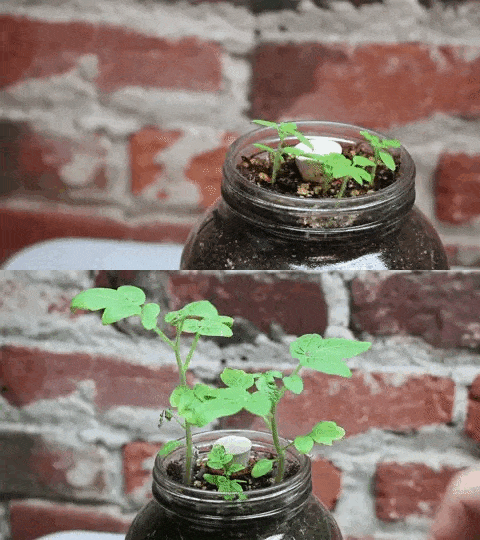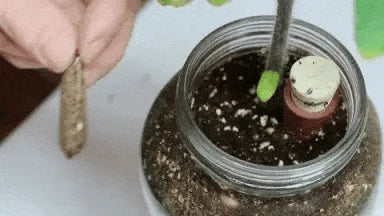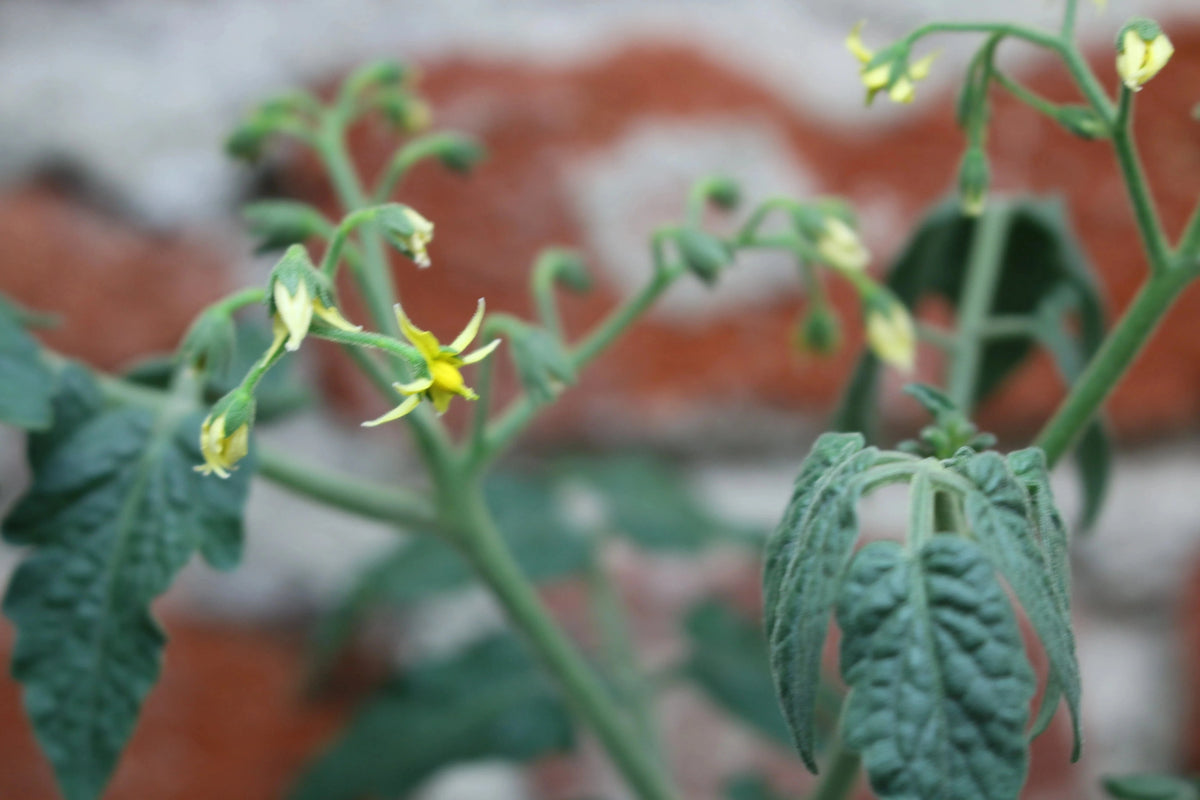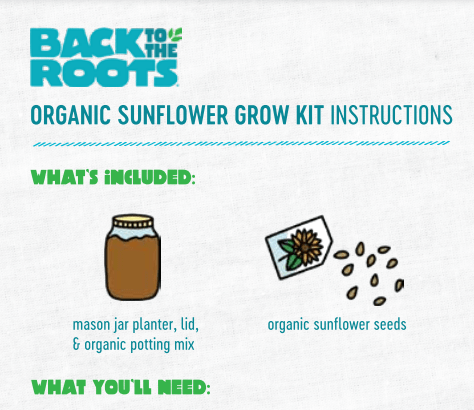Sunflower
LOSE YOUR INSTRUCTION CARD?
Download a digital version of the Tomato Planter Instruction Card by clicking on the image below!
GROW ONE, GIVE ONE
Did you notice our Grow One, Give One campaign on your Planter? At Back to the Roots, we're a small, passionate team on a mission to reconnect families back to where food comes from. As part of that mission, for every Indoor Gardening Kit product you post a photo with, we'll donate the same product & a custom curriculum to an elementary school classroom of your choice! Learn more and send us your photo at BacktotheRoots.com/GiveOne
SETUP
Product Components
Why does it come in a glass jar?
expand_more
We use clear glass because it lets you watch the roots of the plant develop and see how moist your soil is for assessing your plant’s watering needs. The glass jar is also fully reusable and recyclable; after your final harvest you can compost the soil, wash the jar and use it for something else!
Can my sunflower really grow in a small container like this?
expand_more
Yes it can! We selected a special dwarf-type sunflower variety and blended custom soil to make sure you can grow a full flowering plant! Make sure to put your planter in a space with ample sunlight – one of the most important aspects of getting your plant to thrive!
What is your soil made of?
expand_more
Our soil is a custom formulated blend of nutrient-rich ingredients that balance holding enough moisture and allowing for good airflow.
Is your soil organic?
expand_more
Yes! Our soil blend is made of 100% organic materials certified for use in organic gardening by OMRI, sourced from and blended in the United States.
Are these seeds organic?
expand_more
Yes! 100% organic, certified by Oregon Tilth.
Are these seeds Non-GMO?
expand_more
Yes, all of our seeds are non-GMO.
What kind of sunflower am I growing?
expand_more
We’ve selected a special dwarf variety of sunflower called Mardi Gras Blend. These seeds produce spectacular single-petal sunflowers with burnt orange and red hues accenting the traditional yellow petals. They’re designed to grow in containers, so they won’t get too tall and topple over.
Planting & Germination
Should I water my soil first or plant my seeds first?
expand_more
First step is to dampen your soil with 1/2 cup of water before you begin planting seeds.
How many seeds do I need to plant?
expand_more
We recommend planting 5-6 seeds near the center of your jar. If you planted the whole packet already, no problem. You may just have a few more seedlings to trim in the next couple of weeks.
Why push the seeds 1⁄4” into the soil?
expand_more
Your seeds need a warm, moist environment to germinate, and the light 1⁄4" blanket of soil is perfect for that. If left uncovered, the seeds may not be moist enough to sprout, but push them too far into the soil and they may never have the chance to peek their heads up. We’ve found that 1⁄4" is the goldilocks of depths – not too shallow, not too deep, but just right!
How do I make sure my seed germinate?
expand_more
Temperature & moisture are important factors for successful germination:
- Sunflower seeds germinate best in warm soil. Keep your planter in a warm spot like a sunny window or near a heating vent.
- Keep the top 2” of soil consistently moist throughout germination. Carefully add water as needed.
Sunlight + Planter Placement
Where in my home should I put my planter?
expand_more
Your sunflower will thrive in a spot in your home that gets 8+ hours of direct sunlight each day. Most of the time, this will be in a south-facing window - but why is that the case? What's the next best option if that isn't available? How can I tell if my sunlight is direct? All very valid questions - read about finding optimal light for your planter!
What's the best temperature for my sunflower to grow in?
expand_more
Once your sunflower has germinated, it will grow well in normal room temperature (70-75 °F). Ideal conditions for germination are at a slightly higher temperature (80 °F).
GROWTH & CARE
How much water does my sunflower need?
expand_more
Depending on how warm your home is and how much direct light your planter gets, the time between waterings will vary. Peer through your mason jar to check the soil color - as it dries out it will turn a lighter shade of brown. That is your cue to add more water! Additionally, when your sunflower seedlings are small, you will water less frequently than when your plant is larger - so stay vigilant and check your plant often!
My planter is overwatered - what do I do?
expand_more
The best visual indicator of overwatering is when you tilt the jar to its side and see lots of water sloshing around the bottom. Use a thin instrument like a chopstick to poke a hold in the soil down to the bottom of the jar.
You can carefully invert the jar to help drain the water from the soil, and wait until the soil appears fully dry before watering again. Going forward, add less water each time to prevent excess moisture from building up.
What is the green stuff appearing in my soil, around the shoulders of the jar and the sides?
expand_more
The green stuff is algae, which thrives in moist environments while also having lots of direct sunlight. This isn't detrimental to plant growth, but if you want to reduce algal growth add water only once the soil has dried out completely.
There are small flies around my planter, how do I get rid of them?
expand_more
Soil gnats and fruit flies are common indoors when moisture is present, for example when a cup of water left uncovered or in your case, with damp soil. We recommend watering less frequently so that the soil is less moist. In addition, you can create a diluted soapy solution to spray the base of your plants with. Don't worry – this won't harm your plant. Here's a link to our favorite homemade recipe.
Thinning
How do I thin my plant?
expand_more
After germination, you may have multiple sunflower seedlings in your planter. Unfortunately, your container is really only meant to grow one full-size stem, so you’ll need to remove any extras.
2 weeks after planting, remove all but the 3 strongest seedlings. Once these have multiple sets of leaves, remove all but one.
To thin properly, first add a bit of water to the soil to soften. Next, carefully pull out stems by the part of the stem closest to the soil, being cautious to avoid disturbing other plants.

Will thinning hurt my plant?
expand_more
In order to have enough space for the roots to grow, and for your sunflower to grow into a healthy, mature plant with a full bloom!
What happens if I forgot to thin my plants?
expand_more
You can still remove excess plants by trimming using the method mentioned above.
Growth Questions
How big is my sunflower supposed to get?
expand_more
How big your sunflower gets is going to be a result of the environment it’s growing in. Maximize your sunflower size by giving it ample sunlight - preferably 8+ hours!
Generally speaking, your sunflower will grow anywhere between 8 and 24 inches tall. No matter how tall it gets, you’ll be sure to get a big bloom!
How long will it take for my sunflower to bloom?
expand_more
Usually at about 8 to 10 weeks after germination, a flower bud will emerge from the top of the plant stem. It will slowly open over the next 2-3 weeks to reveal a beautiful bloom! Continue to add water and it’ll stay in bloom for weeks!

Do I need to add fertilizer?
expand_more
Sunflowers will grow to full maturity only needing the nutrients we’ve packed into our custom soil blend - no need to add any additional fertilizer or soil amendments!
I have many little plants, but none that are growing very big
expand_more
If your sunflower seems to be stuck as a small plant, a few things can help:
- Thin down to 1 seedling - this will maximize the amount of nutrients for a single stem to grow tall and strong.
- Check your soil - if your plant is overwatered, root growth may be stunted. Drain your planter and let your soil dry out before adding more water.
- Ensure it gets 8 hours of sunlight per day - or supplement sunlight with a grow light.


